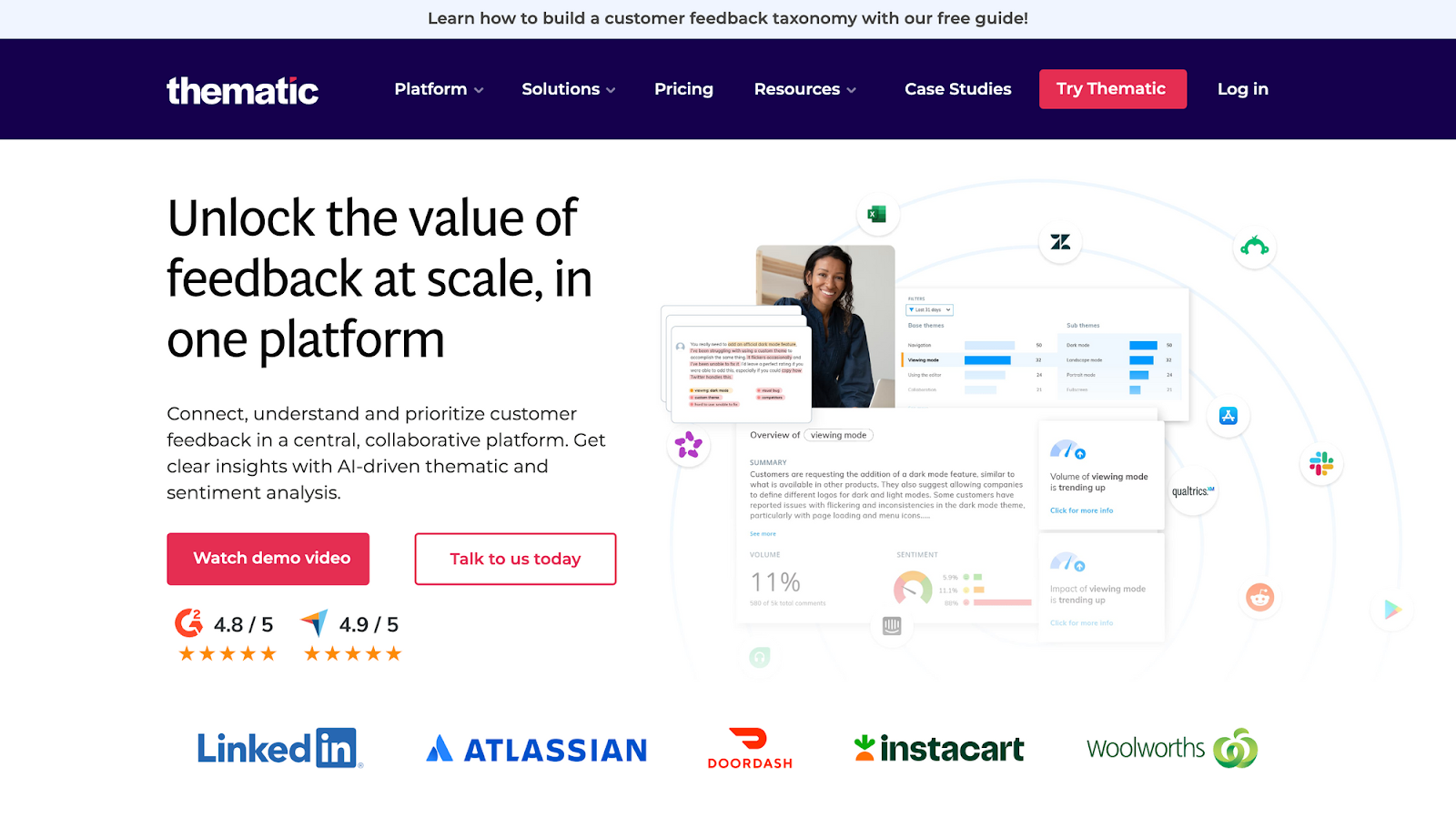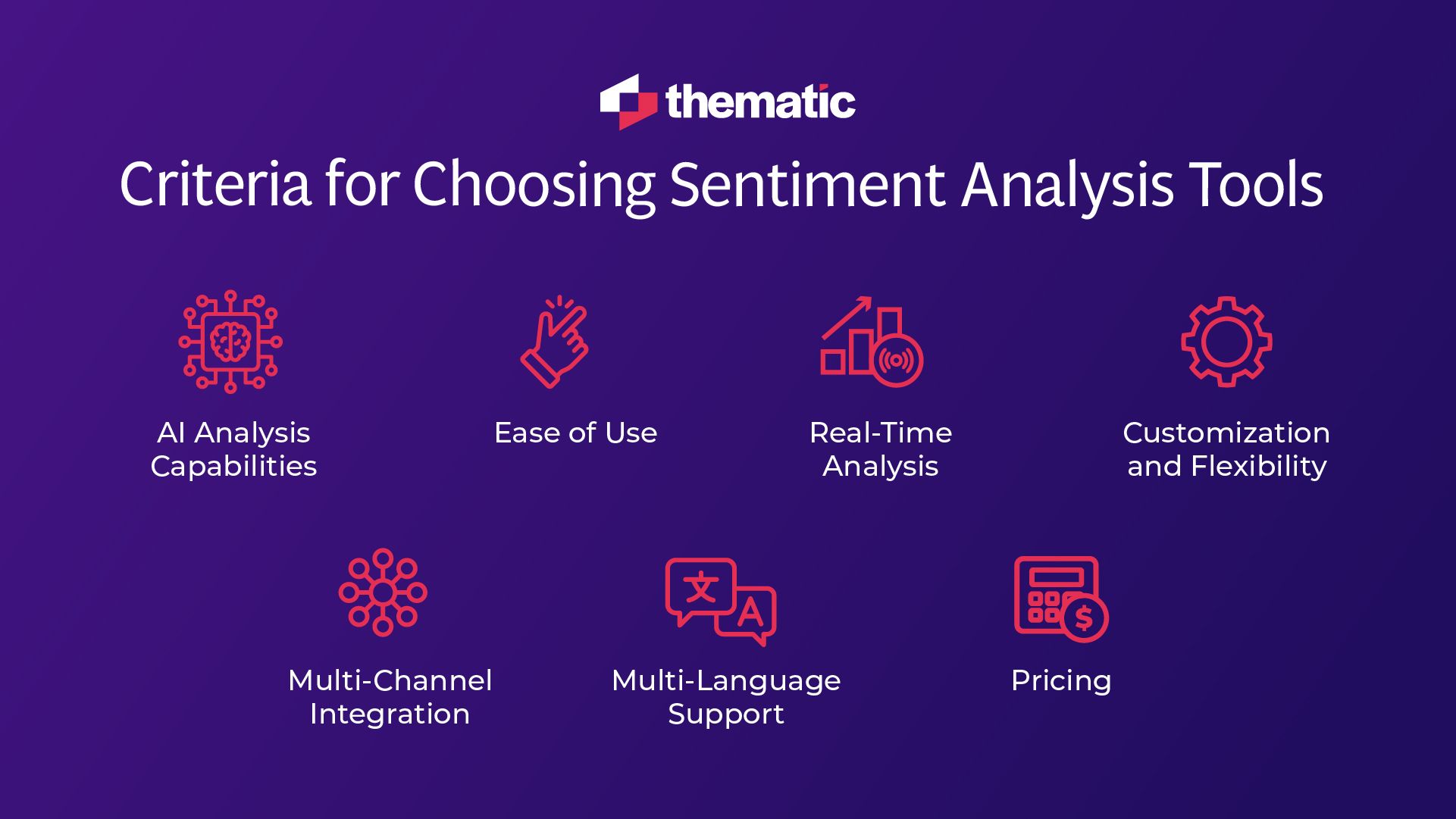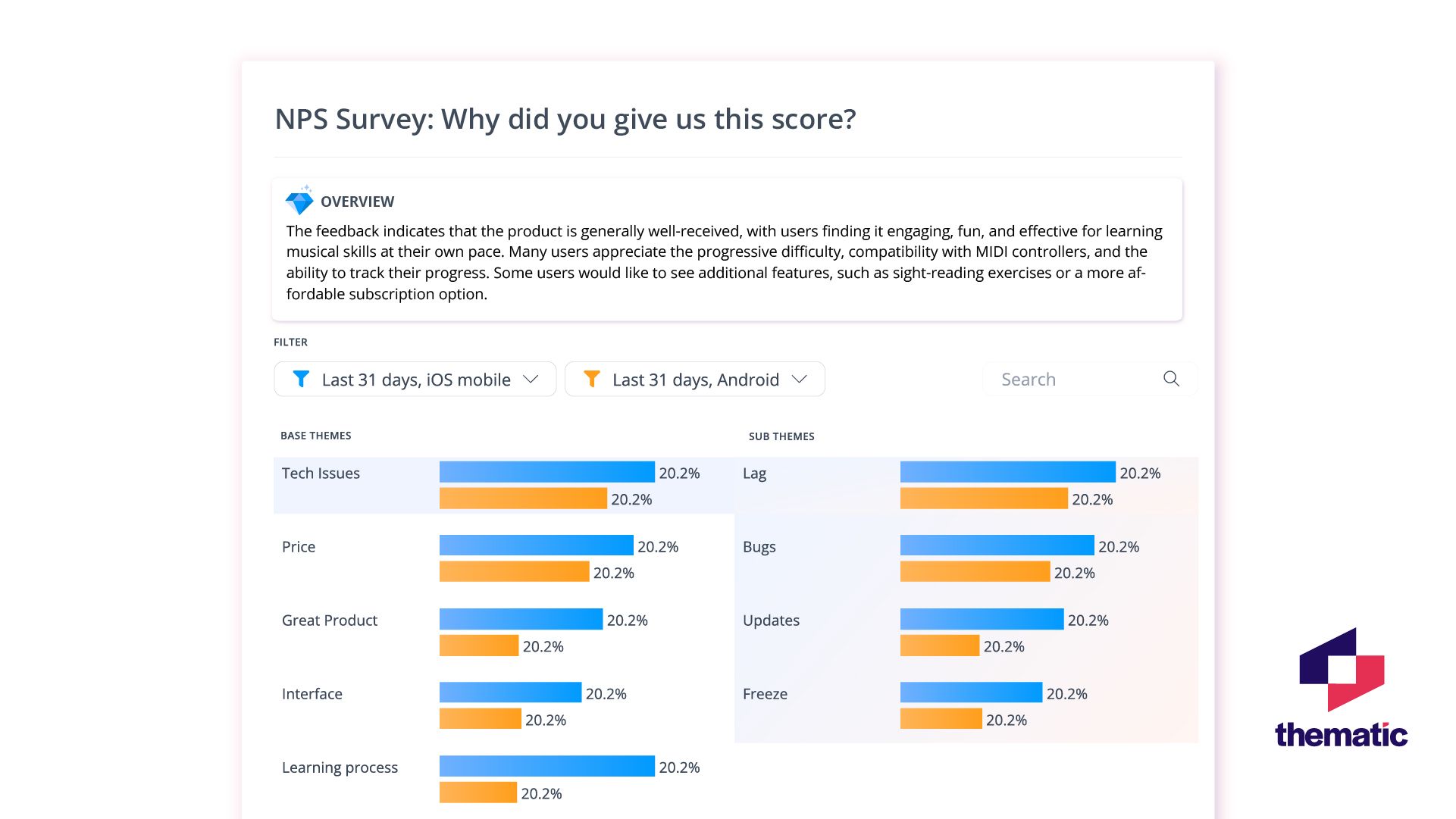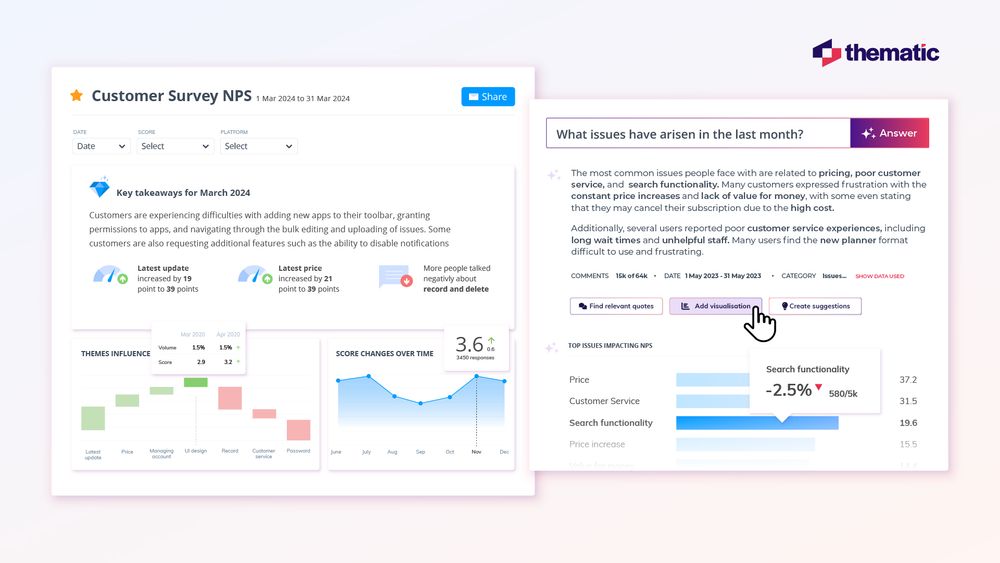
The top traditional and AI sentiment analysis tools that are shaping the way we analyze text.

Between 80-90% of the world’s data is unstructured. That includes customer reviews, social media posts, chat messages, and emails. Making sense of this data can be challenging, especially when you factor in jokes, sarcasm, and other complexities of human language.
Sentiment analysis tools help turn this messy data into clear insights, revealing how people actually feel. Using advanced AI these solutions can capture the full range of human emotion and turn it into actionable insights.
AI sentiment analysis tools make it easy for organizations and researchers to gauge public opinion instantly. Whether you need a simple solution to pick out key customer insights or an advanced AI tool, modern sentiment analysis tools can help you make data-driven decisions much faster.
In this guide we’ll dive into the top traditional and AI sentiment analysis tools that are shaping the way we analyze text. We’ll explore the best tools for each type of business, and also go over some useful criteria to help you choose the right solution.
Short on time? Skip straight to the Best Sentiment Analysis Tools.
Sentiment analysis is the process of determining the emotional tone of textual data. The goal is to classify the sentiment of the text as positive, negative, neutral, or on a more granular scale. This allows you to better understand the writer’s attitude or emotions.
Emotion analysis is a specific type of sentiment analysis that aims to identify and categorize the specific emotions expressed in a piece of text. Sentiment analysis broadly classifies text as positive, negative, or neutral, while emotion analysis seeks to recognize a wider range of emotions like happiness, anger, surprise, or disgust.
Thematic analysis identifies and interprets patterns, themes, and meanings within qualitative data. A theme captures what text is about regardless of which words and phrases express it.
For example, one person could say “the food was yummy”, another could say “the dishes were delicious”. In both cases, it’s the same theme. We could call it “tasty food”.
Sentiment analysis focuses on the feelings and emotions in the text. In this example both sentences have positive sentiment.
Let’s take a quick look at some customer reviews and how you can apply sentiment analysis to understand your customers better. In the image below you can see three different reviews referring to the same theme. Two have negative sentiment and the other positive.

Understanding customer sentiment is crucial for businesses because it can tell you what your customers like and don’t like. As in the example above, you can use this feedback to identify which improvements to prioritize. It’s an essential tool for any organization looking to improve customer satisfaction, retention, and loyalty.
Traditional sentiment analysis uses rules to capture positive and negative sentiment. A very simplistic rule could be “if a sentence contains the word ‘great’, then the sentiment is positive”.
These rules can get quite complex to capture nuanced ways in which sentiment can be expressed. Here’s an example of why it’s difficult.

Creating these rules to maintain consistency is laborious and time-consuming. And that’s where AI comes in. AI sentiment analysis tools have transformed the analysis process, allowing you to accurately process vast amounts of data almost instantly.
One approach is to use Natural Language Processing (NLP) and Machine Learning. The main idea is that a sentiment analysis model learns from examples of text pre-tagged with sentiment. The training data can be created from reviews with ratings or open-ended survey questions linked to satisfaction scores. But it’s still a tedious process.
Most recently, Large Language Models (LLMs) have been successfully applied to this task. Instead of providing training data, you just need to write a prompt. The accuracy of LLM when it comes to sentiment analysis is very high. Here is a quick test on the same data above:

With LLMs you can get more granular too. Here’s a prompt we used to get to specific emotions expressed in text:
“In one word, what emotion does the customer express here. Can you identify a specific emotion for each example?
1. Absolutely ridiculous that you call me at midnight to peddle your insurance offer.
2. I'm fuming that I had to stay on the call for 2 hours only to get disconnected and have to join another queue.
3. It's unheard of to have to call your service just to verify my identity. Why can't I do it online?”
The LLM returned the following results:
1. Annoyance
2. Anger
3. Exasperation
We suspect that LLMs are more accurate than an average person at recognizing sarcasm, detecting emotional intensity, and even understanding cultural differences in language. On the flip side they can be costly to use and often provide inconsistent analysis.
In any case, this is the right time to look at AI-powered sentiment analysis tools and how they can help businesses make better decisions.
Sentiment analysis tools are useful for making sense of qualitative data that companies continuously gather through various channels. Let’s explore some of the most common benefits for organizations and businesses:
Today businesses have access to vast quantities of unstructured customer data, but making good use of this information can be tricky. Advanced sentiment analysis tools like Thematic enable companies to rapidly analyze textual data in thousands of customer reviews, helping them spot common complaints about product quality or delivery issues without manually reading each review.
Why not try out Thematic on your data with a free guided trial and see how it works for you.
Sentiment can be highly subjective. As humans we use tone, context, and language to convey meaning. How we understand that meaning depends on our own experiences and unconscious biases. AI sentiment analysis tools apply consistent criteria to all types of feedback. This minimizes human error and bias and generates more accurate insights.
Let’s take the example of this review: “Gets the job done, but it’s not cheap!” A machine learning model can be trained to recognize that there are two aspects with two different sentiments. It would average the overall sentiment as neutral, but also keep track of the details.
Real-time insights enable businesses to respond faster to urgent issues. For example, a negative story trending on social media can be picked up in real-time and dealt with quickly before it escalates further. By instantly alerting the right teams to fix this issue, companies can prevent bad experiences from happening and limit the fallout.
Thematic’s AI analytics tool allows you to set up alerts so you’ll know as soon as issues arise. You can set up and manage email and Slack notifications using two alert templates: Spike Detection, which triggers based on spikes in volume or sentiment, and Comment Matching, which triggers when individual comments match selected filters.
Now we’ve taken a look at what sentiment analysis can do for your data, we’ll take a closer look at how organizations are using it on a day-to-day basis.

Sentiment analysis is also great for picking up new trends as they develop. Companies like Netflix use sentiment analysis to detect trends in feedback about their shows and platform features. For example, if viewers show a preference for particular genres or story lines, Netflix can prioritize these types of shows to meet customers’ desires.
Other organizations might use this customer feedback to hone their product development pipeline. They might decide to tweak existing products or introduce new features in response to consumer demand.
Marketing campaigns are another area where sentiment analysis can make things more targeted and personalized. Coca-Cola, for instance, might use sentiment analysis on Twitter posts to see if a new campaign resonates positively or if they need to adjust their messaging for better impact.
Sentiment analysis also plays into strategic decision-making. Businesses can monitor competitor sentiment on social media to identify opportunities or areas of weakness. For example, Pepsi could analyze consumer reactions to a Coca-Cola product launch to identify any market gaps and adapt its own campaigns.
How customers feel about a brand can impact sales, churn rates, and how likely they are to recommend this brand to others. Companies can analyze communities, forums and social media platforms to keep an eye on their brand reputation. Or they can conduct targeted surveys to understand the issues their customers feel strongly about.
In this section, we’ll explore the most popular sentiment analysis tools on the market. We’ve curated the list by features and categories so you can find the right tool for you whether you’re looking for real-time feedback on your social media channels or you’re a larger organization seeking an advanced AI analysis.
These tools offer businesses an efficient way to monitor sentiment towards their brand in real-time, enabling them to understand customer emotions and respond swiftly to changes in public perception. Most sentiment analysis tools in this category offer features like real-time sentiment monitoring, social media tracking, and image recognition.
Brandwatch specializes in social media monitoring. The platform helps businesses track and analyze online conversations happening around their brand in real-time. This includes social media platforms, blogs, and news sites.
Key Features:
Brandwatch offers real-time sentiment tracking, customizable dashboards, historical data analysis, and competitive benchmarking. A big pro is that Brandwatch gathers data from lots of different sources, so you get a comprehensive look at online chatter about your organization.
Limitations:
On the flip side, G2 reviewers have reported that it can take a long time for data to load, especially after updating queries. Connecting the platform with your other tools and channels can also be challenging.
Talkwalker is another top social listening platform that helps businesses keep tabs on what’s being said about their brand. Talkwalker monitors a wide range of online sources, ranging from social media and news sites to forums, YouTube videos, and review sites.
Key Features:
Talkwalker offers real-time sentiment and emotion analysis, image recognition, customizable alerts, and a range of industry-specific insights. It’s a versatile tool since you can use it to analyze both your social media mentions and emails and support tickets.
Limitations:
G2 reviewers mention that the price and steep learning curve can make Talkwalker less accessible for smaller businesses.
These tools are designed for Research, Insights, and Customer Experience teams looking to organize large quantities of unstructured feedback. They typically come as part of the CX suite that manages all aspects of managing Voice of Customer or best-of-breed solutions (aimed at solving this specific task).

Thematic is a best-of-breed solution specializing in advanced thematic and sentiment analysis powered by AI. It’s a great option for medium and large companies needing a more accurate understanding of customer sentiment than what’s available as part of the CX suite Thematic works by automatically identifying themes, or topics, in your feedback and layering this with sentiment analysis.
Key Features:
Thematic is designed to handle large volumes of unstructured data from various sources like surveys, social media, and reviews, making it ideal for businesses with extensive customer interactions. Thematic offers robust customization features so organizations can tailor sentiment analysis to their specific needs and industry contexts. Users can create custom themes based on their unique feedback for greater relevance and accuracy. Thematic also leverages Generative AI to continuously improve accuracy and adapt to evolving language patterns.
Limitations:
Thematic does not offer granular emotion analysis beyond positive, neutral, and negative sentiment.
Medallia’s Text Analytics offers customizable machine-learning models that allow users to train the sentiment analysis tool on their specific data.
Key Features:
Before you start using Medallia Text Analytics you have the option to create your own category tags and tag your data. The software then learns to tag your data correctly. Alternatively, you can simplify the process by using their preset text analysis models. Medallia also provides clear visualizations of sentiment trends, making it easier to understand your data at a glance.
Limitations:
Training the model to recognize your category tags can be a time-consuming process. Smaller businesses may need to hire third-party technical help to use Medallia to its full potential.
Lexalytics, now owned by CX suite InMoment, combines Natural Language Processing with Machine Learning to analyze sentiment across various types of text, including social media and customer reviews.
Key Features:
One useful feature is Lexalytic’s ability to detect customer intention. The tool can pick up whether customers intent to leave your brand or to recommend you to others. This information can be handy if you want to boost brand loyalty and customer retention. Users also have the option to fine-tune the sentiment scale for greater accuracy.
Limitations:
Users have reported a steep learning curve with Lexalytics. Customization in particular can be challenging for organizations that don’t have expertise in Machine Learning.
XM Discover, formerly Clarabridge, is the text analytics software offered as part of the Qualtrics suite of products.
Key Features:
XM Discover ranks sentiment in your data on a -5 to 5 point scale on a sentence level. Their Document Explorer feature allows you to sort and filter documents by sentiment. There is also the option to fine-tune their sentiment analysis categories with help from the Discover support team.
Limitations:
Customization of the sentiment analysis process is possible, but only with assistance from XM Discover technical support. Integrating non-Qualtrics platforms and channels can also be challenging.
Small and medium businesses need sentiment analysis tools that offer both affordability and efficient and reliable analytics capabilities. These tools are a great place to get started if you don’t yet have the budget for more advanced AI solutions.
Zoho Analytics is part of the Zoho suite which makes it a good option for those already using the platform. Zoho provides easy-to-use analytics tools, including sentiment analysis, which have been designed with SMBs in mind.
Key Features:
Zoho’s sentiment analysis is powered by Zia. The platform can analyze your emails or customer support tickets to determine the tone. Zoho also have a pay-as-you-go pricing model which is useful for smaller organizations who need to keep costs down.
Limitations:
Zoho’s sentiment analysis capabilities are limited. You can currently only perform analysis on English language texts, and sentiment can only be classified as positive, negative, or neutral. Businesses may quickly outgrow these features.
Social Searcher is a great option for small businesses who want to monitor their presence on social networks and media sites. While it might not have many advanced features, Social Searcher is inexpensive and easy to use even for non-technical teams.
Key Features:
Social Searcher comes with a free sentiment analysis tool where you can check the sentiment behind your online mentions. Reports are divided by channel so it is easy to identify how people feel about your brand on different platforms.
Limitations:
Businesses may quickly outgrow Social Searcher’s limited features and analytics capabilities and need to upgrade to a more advanced solution. Their sentiment analysis in particular is limited to just positive or negative sentiment rather than more nuanced reporting.
With so many tools on the market, choosing the best sentiment analysis tools for your organization can seem daunting. Here are our recommended criteria to consider when selecting a sentiment analysis tool so you can choose one that fits your business needs:

Why It Matters: Not all AI sentiment analysis tools are made equal. Depending on your use case, nuanced analysis might be needed. But in any case, accuracy is key.
What to Look For: Test out the AI analysis capabilities of different tools to understand what will work best for you. Larger organizations with significant amounts of complex unstructured data will likely require a more advanced tool. Generative AI is also becoming increasingly important. Thematic weaves Generative AI into its sentiment analysis models and enables you to get accurate summaries of your data. You should also be aware of critical issues when purchasing AI capabilities. Here’s a helpful buyer’s guide by Esomar and answers by Thematic.
Why It Matters: User-friendly tools save time and reduce training costs. They also allow new or non-technical team members to get up to speed faster.
What to Look For: Look for an intuitive interface, clear instructions, and helpful onboarding resources. Tools like Thematic are designed with simplicity in mind and include demo videos and a dedicated Knowledge Base to help you learn the basics.
Why It Matters: Real-time tracking can be essential for companies that need to monitor sentiment as it happens, such as during product launches or PR crises. It’s less valuable for Voice of Customer programs focused on finding common customer issues with a specific time period.
What to Look For: Select tools that offer real-time data processing and customizable alerts. Look for tools that enable you easily to set up alerts direct to your email or Slack channels so the appropriate team members can see them.
Why It Matters: Your business might need specific insights or custom categories beyond out-of-the-box functionality. Customization ensures the tool can adapt to your unique needs.
What to Look For: Check if the tool allows you to create custom categories, tweak algorithms, or apply industry-specific models. For example, with Thematic you can edit and delete “themes” or topics with the dedicated Theme Editor tool. This ensures greater accuracy and improves the quality of your insights.

Why It Matters: Strong integration capabilities make it easy to get all of your customer data in one place.
What to Look For: Ensure the tool you select can easily integrate with your existing CRM, social media management tools, and analytics platforms. Most popular tools offer built-in integrations to all the major platforms.
Why It Matters: If your business operates globally, you’ll probably need a tool that can analyze customer feedback across different languages and dialects.
What to Look For: Assess which tools offer robust language support, especially if you need to analyze feedback from non-English-speaking customers.
Why It Matters: As your organization grows you may need to process larger volumes of data. You might choose to start with a simpler, more inexpensive tool and then upgrade to a more advanced AI tool in the future.
What to Look For: Consider whether the tool you choose matches your current data volumes and if it offers price brackets for different-sized businesses.
Why It Matters: Pricing is often the deciding factor when it comes to choosing a tool that satisfies all stakeholders. The best solution is one that fits your budget without sacrificing essential features.
What to Look For: Compare what you get from each pricing model and decide which features are essential for you. Thematic offers flexible pricing plans which are tailored to your organization depending on how much data you have.
AI analysis tools like Thematic allow you to get started with sentiment analysis right away. Here’s how you can use Thematic to get the best results from your feedback data.
Thematic’s one-click integrations into feedback collection tools and APIs enable seamless and secure data transfer. These include Qualtrics, Trustpilot, Amazon, Facebook, Intercom, Twitter, Tripadvisor, and many more. Thematic then automatically cleans and prepares your data so it’s ready to be analyzed.
Thematic uses sentiment analysis algorithms that are trained on large volumes of data using machine learning. A unique feature of Thematic is that it combines sentiment with “themes”, or specific topics, discovered during the thematic analysis process.
Thematic’s AI automatically groups themes into a 2-level taxonomy. For a given text there will be core themes and related sub-themes. In the image below you can see the top themes for a dataset and the sub-themes displayed below these. You also have the option to edit themes in the Theme Editor to make your results more accurate and relevant to your organization.

Thematic uses sentiment analysis with thematic analysis to help you understand the emotion behind a theme. Sentiment analysis scores each piece of text or theme and assigns positive, neutral or negative sentiment.
In the example below you can see the theme “print boarding passes”. Thematic enables you to dig deeper and understand how your customers feel about this topic using the sentiment scores. In this case we can see that Southwest’s lack of assigned seating is associated with negative sentiment. This could be a good area for improvement!

Once you’ve analyzed your data, you need to take action on your findings. Bear in mind that stakeholders who understand your insights are more likely to take action.
Thematic’s clear visualizations make it easy to share your valuable insights with all stakeholders in your organization. You can easily drill down into your customer feedback data to see exactly what the problem is, and share this information with the right people in your organization.
Next-generation sentiment analysis tools like Thematic use the latest advances in AI to help you do even more with your insights. In the image below you can see how you can use Thematic Answers to ask questions and get answers directly from your data.

Choosing the right sentiment analysis software can help turn your unstructured feedback into valuable insights that actually make a difference. And don’t forget to keep one eye on the future when you’re making your choice.
Ongoing developments in AI are making sentiment analysis ever easier and faster. And you need a tool that can keep up with these changes to help your business stay competitive. Embracing AI-driven sentiment analysis tools is a great way to understand your customers on a deeper level and keep up with market developments.
Still not sure which sentiment analysis tool is right for you? The best way to find out is to try them out for yourself. Why not start right here with a free guided demo of Thematic using your own data.
Join the newsletter to receive the latest updates in your inbox.